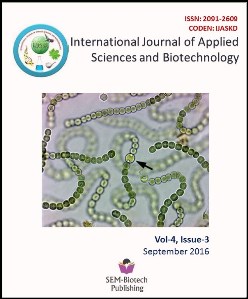Cumulative Effects of Ultraviolet Radiation and Photosyntheically Active Radiation on Phycobiliproteins of A Hot-Spring Cyanobacatrium Nostoc sp. strain HKAR-2
DOI:
https://doi.org/10.3126/ijasbt.v4i3.15595Keywords:
Cyanobacteria, Fluorescence, Phycocyanin, Phycoerythrin, UV radiationAbstract
Cyanobacteria are cosmopolitan in distribution and have adapted to diverse habitats. Adaptation of cyanobacteria is one of the key factors to withstand harsh environmental conditions. We have investigated the effects of photosynthetically active radiation (PAR; 400–700 nm), ultraviolet-B (UV-B; 280–315 nm) radiation and PAR+UV-B radiations on phycobiliproteins (PBPs) of a hot-spring cyanobacterium Nostoc sp. HKAR-2. There was a continuous induction of both phycoerythrin (PE) and phycocyanin (PC) after exposure of PAR up to 300 min. However, there was an induction in the synthesis of both PE and PC up to 240 min exposure of UV-B and PAR+UV-B radiations. Further exposure showed decline in the synthesis due to rapid uncoupling, bleaching and degradation of PBPs. Similarly, emission fluorescence also showed an induction with a shift towards longer wavelengths after 240 min of UV-B and PAR+UV-B exposure. These results indicate that short duration of UV radiation may promote the synthesis of PBPs that can be utilized in various biotechnological and biomedical applications.
Int J Appl Sci Biotechnol, Vol 4(3): 247-253




